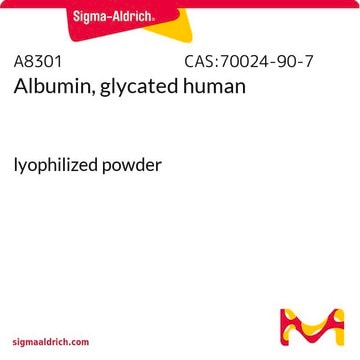The stability of this product in solution has not been evaluated. Generally, peptides should not be stored in solution for extended periods. Should solution storage be necessary, storing aliquots at -20°C is suggested. Note that peptides have a tendency to stick to plastic containers upon storage.
Wichtige Dokumente
G9145
[Leu15]-Gastrin I Human
≥95% (HPLC)
Synonym(e):
[Leu15]-HG-17, LHG-17, [15-Leucin]-Gastrin I-, humanes Heptadecapeptid, [18-Pyroglutaminsäure, 32-Leucin]-Big-Gastrin I-(18-34)-peptidamid, human, [Leu15]-Gastrin I , Human, [Leucin15]-Gastrin I-heptadecapeptid, [Leucin15]-Little-Gastrin I
Größe auswählen
Größe auswählen
About This Item
Empfohlene Produkte
Biologische Quelle
human
Qualitätsniveau
Assay
≥95% (HPLC)
Form
powder
Methode(n)
cell culture | mammalian: suitable
UniProt-Hinterlegungsnummer
Lagertemp.
−20°C
SMILES String
CC(C)CC(NC(=O)C(Cc1c[nH]c2ccccc12)NC(=O)C3CCCN3C(=O)CNC(=O)C4CCC(=O)N4)C(=O)NC(CCC(O)=O)C(=O)NC(CCC(O)=O)C(=O)NC(CCC(O)=O)C(=O)NC(CCC(O)=O)C(=O)NC(CCC(O)=O)C(=O)NC(C)C(=O)NC(Cc5ccc(O)cc5)C(=O)NCC(=O)NC(Cc6c[nH]c7ccccc67)C(=O)NC(CC(C)C)C(=O)NC(CC(O)=O)C(=O)NC(Cc8ccccc8)C(N)=O
InChI
1S/C98H126N20O31/c1-49(2)38-68(115-96(147)72(43-55-46-101-60-19-12-10-17-58(55)60)117-98(149)74-20-13-37-118(74)77(122)48-103-86(137)61-25-31-75(120)105-61)93(144)111-66(30-36-82(131)132)92(143)110-65(29-35-81(129)130)91(142)109-64(28-34-80(127)128)90(141)108-63(27-33-79(125)126)89(140)107-62(26-32-78(123)124)88(139)104-51(5)85(136)113-70(41-53-21-23-56(119)24-22-53)87(138)102-47-76(121)106-71(42-54-45-100-59-18-11-9-16-57(54)59)95(146)114-69(39-50(3)4)94(145)116-73(44-83(133)134)97(148)112-67(84(99)135)40-52-14-7-6-8-15-52/h6-12,14-19,21-24,45-46,49-51,61-74,100-101,119H,13,20,25-44,47-48H2,1-5H3,(H2,99,135)(H,102,138)(H,103,137)(H,104,139)(H,105,120)(H,106,121)(H,107,140)(H,108,141)(H,109,142)(H,110,143)(H,111,144)(H,112,148)(H,113,136)(H,114,146)(H,115,147)(H,116,145)(H,117,149)(H,123,124)(H,125,126)(H,127,128)(H,129,130)(H,131,132)(H,133,134)
InChIKey
CMVMLPDUAGUTOC-UHFFFAOYSA-N
Angaben zum Gen
human ... GAST(2520)
Suchen Sie nach ähnlichen Produkten? Aufrufen Leitfaden zum Produktvergleich
Amino Acid Sequence
Allgemeine Beschreibung
Anwendung
Biochem./physiol. Wirkung
Sonstige Hinweise
Lagerklassenschlüssel
11 - Combustible Solids
WGK
WGK 3
Flammpunkt (°F)
Not applicable
Flammpunkt (°C)
Not applicable
Persönliche Schutzausrüstung
Eyeshields, Gloves, type N95 (US)
Hier finden Sie alle aktuellen Versionen:
Analysenzertifikate (COA)
Die passende Version wird nicht angezeigt?
Wenn Sie eine bestimmte Version benötigen, können Sie anhand der Lot- oder Chargennummer nach einem spezifischen Zertifikat suchen.
Besitzen Sie dieses Produkt bereits?
In der Dokumentenbibliothek finden Sie die Dokumentation zu den Produkten, die Sie kürzlich erworben haben.
Kunden haben sich ebenfalls angesehen
Artikel
Human pancreatic cancer organoid biobank (PDAC organoids) with various KRAS mutations to aide in 3D cell culture and cancer research applications.
-
After preparing aliquots, what is the stability of this product at -20?
1 answer-
Helpful?
-
-
Is this product also suitable for use with other mammalian species, such as mouse, for ex vivo tissue studies, as opposed to just human organoid culture medium?
1 answer-
The product's validation for batch release does not currently cover murine ex vivo tissue testing. However, the following citations may provide insights into its application for ex vivo non-human samples:
Sci Adv. 2023 Nov 17;9(46):eadh0322. Title: Inactivation of the tumor suppressor gene Apc synergizes with H. pylori to induce DNA damage in murine gastric stem and progenitor cells PMID: 37967175
Infect Immun. 2016 Sep 19;84(10):3083-91. Title: Intestinal Enteroids Model Guanylate Cyclase C-Dependent Secretion Induced by Heat-Stable Enterotoxins PMID: 27481254
Helpful?
-
-
I am interested in this product. A colleague uses it for human organoid culture medium. However, I work with murine ex vivo tissues. Is this also applicable for other mammalian species (so mouse in stead of human)?
1 answer-
This product has not been tested for use with murine ex vivo tissue. However, the following citations may be of interest for its application in ex vivo non-human samples.
Sci Adv. 2023 Nov 17;9(46):eadh0322.
Inactivation of the tumor suppressor gene Apc synergizes with H. pylori to induce DNA damage in murine gastric stem and progenitor cells
PMID: 37967175
https://pubmed.ncbi.nlm.nih.gov/37967175/Infect Immun. 2016 Sep 19;84(10):3083-91.
Intestinal Enteroids Model Guanylate Cyclase C-Dependent Secretion Induced by Heat-Stable Enterotoxins
PMID: 27481254
https://pubmed.ncbi.nlm.nih.gov/27481254/Helpful?
-
-
この製品の溶媒は何を用いればよろしいでしょうか。水またはPBS(-)には溶けますでしょうか、あるいはDMSOでしょうか。
1 answer-
This product is tested for solubility at 1mg/ml in 0.1% NaOH or 1% NH4OH. Other solvents have not been evaluated.
Helpful?
-
Active Filters
Unser Team von Wissenschaftlern verfügt über Erfahrung in allen Forschungsbereichen einschließlich Life Science, Materialwissenschaften, chemischer Synthese, Chromatographie, Analytik und vielen mehr..
Setzen Sie sich mit dem technischen Dienst in Verbindung.








![[Leu15,Gly18]-Gastrin2-17](/deepweb/assets/sigmaaldrich/product/images/384/185/d3095ca6-fe9a-4e1c-b2e9-29ad2bd40c46/640/d3095ca6-fe9a-4e1c-b2e9-29ad2bd40c46.jpg)
![[Gly18]-Gastrin 1-17 human](/deepweb/assets/sigmaaldrich/product/images/973/112/79e0734e-033a-4a31-9368-b08610cdcfd1/640/79e0734e-033a-4a31-9368-b08610cdcfd1.jpg)




